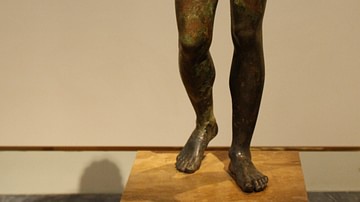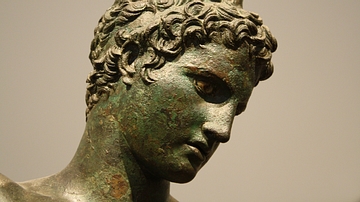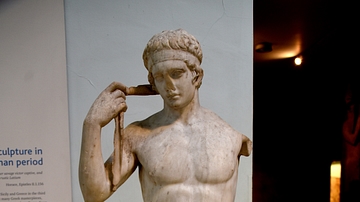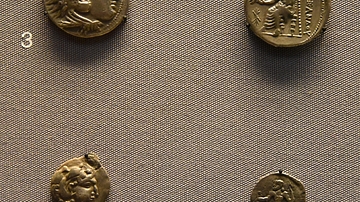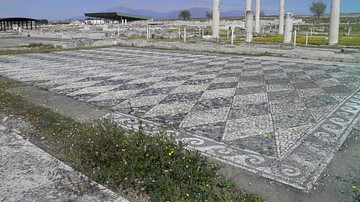Illustration
Bronze figurine of a female athlete, found in the archaeological site of Samoil's Fortress in Ohrid, North Macedonia, 2nd to 1st centuries BCE.
NI Institute for Protection of Monuments of Culture and Museum of Ohrid.
Tsar Samoil's Fortress is a monumental fortification with sturdy stone walls and soaring towers up to 53 feet (16 m) high. The ramparts are spread across the acropolis of Ohrid, the capital of the First Bulgarian Empire. Recent excavations have revealed the existence of an original castle built on the site in the 4th century BCE, linking its foundation with Philip II of Macedon. The current fortress, however, is the result of an extensive and presumably expansive renovation project under Tsar Samuel of Bulgaria in the 11th century. Like many other parts of Ohrid, diggings in the site have brought a vast and variable range of artefacts to light. Finding bronze statues of the Greco-Roman deities and persons provides invaluable links to the classical history of the city in the Hellenistic Macedonian and then Roman eras.
The bronze figurine of a female athlete, with her breasts tightly flattened in her strophium, is part of a retrieved hoard of often fragmentary bronze sculptures including Hercules, a mace, and various body parts of one or more horses. This assemblage implies that the Ohrid acropolis could once be home to major temples and sacred precincts, where the athletes would bring offerings to ask or thank for their victory. In fact, the Samoil's Fortress is not far from the city's ancient theatre, established in the 7th or 6th century BCE as a Greek theatre but later converted by the conquering Romans to be used as an arena for gladiator fights. In a distinctive difference with the Greek world, women at least in the late Republic and early Roman Empire had more chances to train and track their athletic prowess. Apart from footraces, acrobatic dances, and rhythmic gymnastics performed with different balls, they could be watched and applauded in gladiatorial combats. Related evidence can be found in ancient written and pictorial works, including a marble relief from Halicarnassus, contemporary to the Ohrid bronze figurine, depicting two female gladiators, named Amazon and Achillia, in the position of confrontation.
About the Author
Photo Location
This photograph was taken at the following location:
External Links
Cite This Work
APA Style
Choubineh, N. (2024, August 26). Bronze Figurine of a Female Athlete from the Roman Macedonia. World History Encyclopedia. Retrieved from https://www.worldhistory.org/image/19346/bronze-figurine-of-a-female-athlete-from-the-roman/
Chicago Style
Choubineh, Nathalie. "Bronze Figurine of a Female Athlete from the Roman Macedonia." World History Encyclopedia. Last modified August 26, 2024. https://www.worldhistory.org/image/19346/bronze-figurine-of-a-female-athlete-from-the-roman/.
MLA Style
Choubineh, Nathalie. "Bronze Figurine of a Female Athlete from the Roman Macedonia." World History Encyclopedia. World History Encyclopedia, 26 Aug 2024, https://www.worldhistory.org/image/19346/bronze-figurine-of-a-female-athlete-from-the-roman/. Web. 03 Jul 2025.




